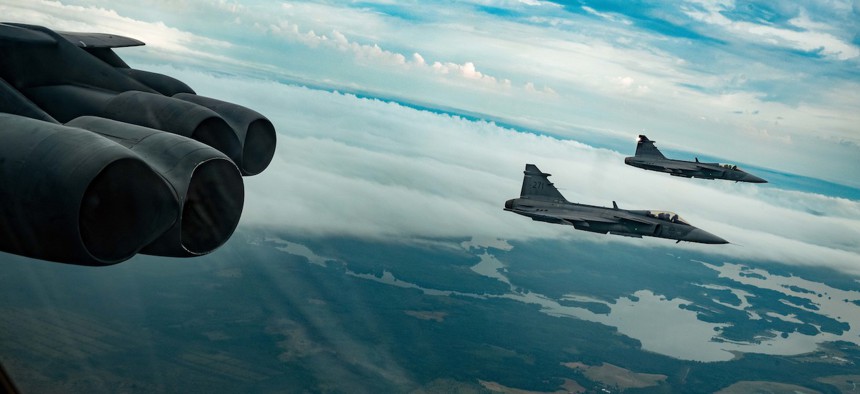
Two Swedish Air Force Saab JAS 39 Gripens escort a U.S. Air Force 23rd Expeditionary Bomb Squadron B-52H Stratofortress over Sweden during a Bomber Task Force mission Aug. 27, 2022. U.S. Air Force / enior Airman Michael A. Richmond
The Air & Space Brief: The case for selling F-16s to Argentina; Boosting officer diversity; What the Artemis launch means for DOD
Welcome to the Defense One Air and Space newsletter. Here are our top stories this week:
The argument for Argentina: The United States should sell F-16s to Argentina despite the 40-year-old rift between Buenos Aires and the United Kingdom, researcher Santiago Previde argued in an op-ed. While the 1982 conflict is behind the UK’s efforts to block the sale of jets to Argentina today, withholding the planes will only push Buenos Aires closer to China and Russia, who are both willing to sell their own advanced platforms. If the United States does not act, “Argentina’s air force might soon have the first western pilots flying Chinese fighter jets,” Previde writes.
A more diverse Air and Space Force: Air Force Secretary Frank Kendall directed the Air and Space Force commissioning sources, including the Air Force Academy and Officer Training School, to develop a plan by Sept. 30 to increase racial and gender diversity in the services’ applicant pool. The new diversity goals for the officer corps, which will be considered alongside existing merit-based requirements, aim for a service that is 64 percent men and 36 percent women. As of June 30, just 23 percent of officers are women.
China’s rise in orbit: The United States must take “urgent action” to unite around a common goal in space, or risk being overtaken by China, a new Pentagon report on the space industrial base warned. Beijing has been focused on its space ambitions, including goals to build a space station in low-Earth orbit and conduct short missions on the moon this decade, and already has a list of accomplishments including landing on the far side of the moon in 2010 and landing on Mars in 2021. But changes in America’s space goals driven by politics and administration changes have left it without a “North Star vision” around which experts and the American public can unite.
Moon mission still on the pad: NASA’s first uncrewed launch to the moon, which was expected to lift off Monday, was scrubbed due to an engine issue. But, whenever Artemis is able to launch, it will represent the first step toward a new lunar domain that the military will someday need to watch and protect. Even though U.S. Space Command’s area of responsibility is anything above 100 kilometers, seeing what’s happening on and around the moon is a current blind spot—one the military should seek to close ASAP, according to some experts.
Join us live! We’ll be chatting on Twitter Spaces after the next launch attempt at 3 p.m. Friday about the Artemis program, other nations’ lunar aspirations, and the national security implications of building on the moon.
Sign up to get The Air & Space Brief every Tuesday from Tara Copp, Defense One’s Senior Pentagon Reporter. This week’s edition is brought to you by Jacqueline Feldscher, Defense One’s Senior National Security Reporter. On this day in 1984, the space shuttle Discovery launched from Kennedy Space Center on its first mission.
 From Defense One
From Defense One
The US Just Revealed a Secret Airborne Test of a Long-Range Cruise Missile // Marcus Weisgerber
The December test was part of the effort to equip B-2 bombers to fire the stealthy JASSM-ER.
This Gen-Z Value Could Spell Trouble for Spec Ops Community // Elizabeth Howe
CNA looked at the leadership traits valued by today's youth, special operators, and strategists of tomorrow.
'We Need to Own the Heat The Way We Now Own Night,' Pentagon Climate Leader Says // Patrick Tucker
Tactical cooling vests and other adaptations will be needed as dangerous temperatures arrive on training ranges and in combat zones.




